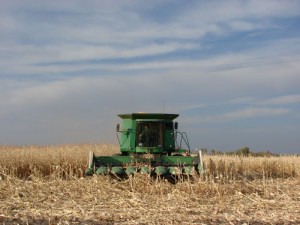
Corn acres are up in Northwestern Minnesota, which means more demand for corn research and information.
Blizzards, road closures, winter storms and wind chill warnings didn’t stop more than 400 farmers in Northwest Minnesota from attending a series of Small Grains Update meetings in mid-January. Minnesota grower associations representing corn, soybean and wheat braved the tricky roads and icy conditions to meet with growers at eight locations over four days to cover many important topics.
The meetings were held in conjunction with local crop improvement meetings and county soybean and corn grower association annual meetings. Together the associations, check-off organizations and University of Minnesota Extension provided information on research results, production decisions, state agriculture policy, regulations and environmental issues.
“Historically the Small Grains Update meetings have been focused on wheat production, marketing and policy,” said Dave Toergerson, executive director of the Minnesota Wheat Growers Association. “However in 2014 we wanted to change it up by adding corn and soybean topics. That decision was based on the changes taking place in the crop rotations in Northwest Minnesota and the Association’s desire to better serve growers by providing a mix of information on three crops at one meeting instead of having three separate meetings.”
By all accounts, growers attending the meetings appreciated the mix, Torgerson added. Over 95 percent of those filling out surveys at the meetings said they were pleased that the associations were working together and they liked having topics presented on all three crops.
One of the most important topics covered was water quality and environmental issues. Adam Birr, PhD. and research director for the Minnesota Corn Growers teamed up with Bruce Kleven, state lobbyist for the Minnesota Wheat Growers to connect the realities of the Minnesota political environment with the need to find science-based information and solutions before reactionary actions by the state legislature.
Kleven highlighted how two metro counties can change state decisions simply because of their large populations and political alignment. Kleven said there is pressure to move regulatory attention and policy from point source pollutants from factories or city waste water treatment plants to non-point sources like individual fields or other natural sources. Kleven said ag group leaders are working closely together with legislators who understand agriculture and rural issues, but the number of legislators from the rural areas is dwindling.
Birr had an important perspective to share on these issues because farmers in the Southern part of the state have been dealing with environment questions longer then farmers in the Northwest. Birr was able to share some important perspective that should help Northwest Minnesota growers and their associations get ahead of the issue.
“Corn check-off funded research not only focuses on productivity and yields, but it also focuses on stewardship,” Birr said. “It is important to have the science-based data that will help make better policy decisions.”
One way Minnesota corn and soybean farmers are gathering on-farm data is through Discovery Farms Minnesota, which is a farmer-led effort to better understand the relationship between production practices and water quality. In addition to many southern sites, Discovery Farms has two on-farm sites in Northwest Minnesota, one in the Rothsay area and the other in the Twin Valley area. Both are beginning to collect important information for Northwest Minnesota farmers.
Birr also highlighted a tile drainage research site in Clay County led by the Minnesota Department of Agriculture and encouraged growers to learn from the experiences of other regions in the state.
“Stay ahead of the issue by being involved and to use science-based information for both the political process and the process of constantly evolving and improving production practices,” he said. “The Minnesota Corn Growers are here to help. So are the other grower associations, researchers, the U of M and the Minnesota Department of Agriculture.”
Northwest Minnesota’s cropping system is also changing and evolving. In the Northwest Crop Reporting District of Minnesota, which includes the counties north of highway 10, corn acres increased by 71 percent from 2007-12. Acres planted to wheat over the same period and in the same reporting district decreased by 25 percent.
In 2012 total corn acres in the Northwest District was at 554,000 and wheat acres were at 955,000. Soybean acres in the Northwest District came in at 1,475,000. Some of the counties in the district have seen much more dramatic changes over the last five years.
Other topics included a report on the Coordinated County Soybean Variety trials conducted in both Northwest Minnesota and North Dakota and a discussion on soybean variety selection. Both presentations were relevant for all crops because the best methods for making the all-important variety/hybrid decisions are based on the same principles of multi-location data, multi-year data, statistics and consideration of traits beyond yield.
Wheat variety trial results were also presented along with new research showing that wheat root disease is more prevalent than previously anticipated and research efforts underway to combat the issue.

